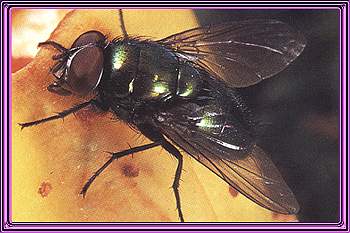
Lucilia caesar
(Greenbottle)
This fly belongs to the CALLIPHORIDAE family and is bluish green to emerald, often becoming coppery with age. The eyes are bare and the jowls silvery. The 4th long vein in the wing is sharply bent, and the size varies. It is found on dung, carrion and flowers everywhere, but not often found indoors. The larvae can sometimes be found in wounds on sheep and other animals. Please see bluebottle for further information. The adult Calliphora oviposits 4-5 days after emergence. Eggs are deposited on carrion or other suitable media. Depending on the species of fly and the season and situation, oviposition can occur immediately after death of the host, or up to 2 days after death. A female can lay 540-720 eggs in her lifetime in batches of up to 180 eggs. Upon hatching, larvae penetrate the skin or hide via natural or unnatural openings (i.e., wounds). Development takes from 15 to 27 days, depending on species and temperature. Larvae leave the corpse in large numbers and pupate in the top 5 to 8 cm of soil, and up to 6 m from a corpse. These flies overwinter as prepupae, pupae, or adults.